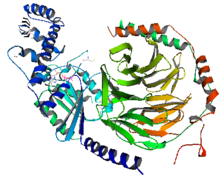Heterotrimeric G protein

Heterotrimeric G proteins are GTP-binding proteins ( G proteins ) consisting of three subunits (α, β and γ ). They are of great importance for the transmission of signals outside the cell into the cell interior ( signal transduction ) and are responsible for physiological (e.g. sight, smell, blood pressure regulation etc.) and pathophysiological effects (e.g. hypertension, heart failure etc. .).
After activation of a G-protein-coupled receptor, they disintegrate into an activated α-subunit on the one hand and into a βγ-subunit on the other hand, exchanging GDP for GTP .
function
Activation of heterotrimeric G proteins
Heterotrimeric G proteins are allosterically regulated proteins by G protein-coupled receptors . They can be activated cyclically by these receptors:
- In the inactive state, they exist as heterotrimers consisting of one α, one β and one γ subunit. In this state GDP is bound.
- This heterotrimer can bind to a receptor.
- Activation of a G protein-coupled receptor leads to activation of the bound heterotrimer and thus to an exchange of GDP for GTP. The parties involved in GTP exchange factors (GTP exchange factors, GEFs) involved.
- Because of the bound GTP, the heterotrimer loses its stability. This results in a change in the conformation of the heterotrimeric G protein or its breakdown into a GTP-α and a βγ subunit.
- The α-subunit is an allosterically regulated GTPase that is activated by GTPase-activating proteins . It catalyzes the hydrolysis of the bound GTP to GDP.
- GDP-α-subunits and βγ-subunits can associate again.
Activation of downstream signal transduction pathways
Activated G proteins are able to influence downstream signal transduction pathways. The α-subunits can, for example, activate or inhibit adenylyl cyclase and thus change the concentration of the second messenger cyclic adenosine monophosphate (cAMP). Furthermore, they can activate phospholipases and protein kinases or modulate ion channels . The βγ subunit can also be of importance in the regulation of second messengers; some effectors, such as certain ion channels, are regulated directly by βγ subunits. A measurable effect is triggered directly or indirectly by changing the second messenger concentration.
Classification
The α-subunit, of which more than 20 isoforms are known, is particularly important for signal transduction . Based on their properties, these isoforms are essentially grouped into 4 families (α s , α i , α q and α 12/13 ), after which the G proteins are named accordingly (G s , G i , G q and G 12 / 13 ).
| G protein family | α subunits | Signal transduction | Occurrence / receptors | Effects (examples) |
| G i family | ||||
| G i / o | α i , α o | Inhibition of adenylyl cyclase, inhibition of cAMP formation, opening of potassium channels, inhibition of calcium channels | heptahelical hormone and neurotransmitter receptors, (e.g. muscarinic receptors , chemokine receptors , α 2 -adrenoceptors ) | Smooth muscle contraction, inhibition of the conduction of excitation |
| G t | α t ( transducin ) | Activation of phosphodiesterase 6, degradation of cGMP | Rhodopsin | See |
| G gust | α gust ( Gustducin ) | Activation of phosphodiesterase 6, degradation of cGMP | Taste receptors | taste |
| G z | α z | Inhibition of adenylyl cyclase | ? | ? |
| G s family | ||||
| G s | α s | Activation of adenylyl cyclase, formation of cAMP | heptahelical hormone and neurotransmitter receptors (e.g. beta adrenoceptors ) | Increase in heart rate, relaxation of smooth muscles , conduction of excitation |
| G olf | α olf | Activation of adenylyl cyclase, formation of cAMP | olfactory receptors | Smell |
| G q family | ||||
| G q | α q , α 11 , α 14 , α 15 , α 16 | Activation of phospholipase C , formation of IP 3 and DAG | heptahelical hormone and neurotransmitter receptors (eg. B. α 1 -adrenoceptors , H 1 receptors , AT 1 receptors, metabotropic glutamate receptor Group I) | Smooth muscle contraction, conduction of excitation |
| G 12/13 family | ||||
| G 12/13 | α 12 , α 13 | Activation of the Rho GTPases and Rho kinases | heptahelical hormone and neurotransmitter receptors (e.g. thromboxane A 2 receptors) | Cytoskeletal functions, smooth muscle contraction |
literature
- Jeremy M. Berg, John L. Tymoczko, Lubert Stryer : Biochemistry. 6th edition, Spektrum Akademischer Verlag, Heidelberg 2007. ISBN 978-3-8274-1800-5 .
- Donald Voet, Judith G. Voet: Biochemistry. 3rd edition, John Wiley & Sons, New York 2004. ISBN 0-471-19350-X .
- Bruce Alberts , Alexander Johnson, Peter Walter, Julian Lewis, Martin Raff, Keith Roberts: Molecular Biology of the Cell , 5th Edition, Taylor & Francis 2007, ISBN 978-0815341062 .